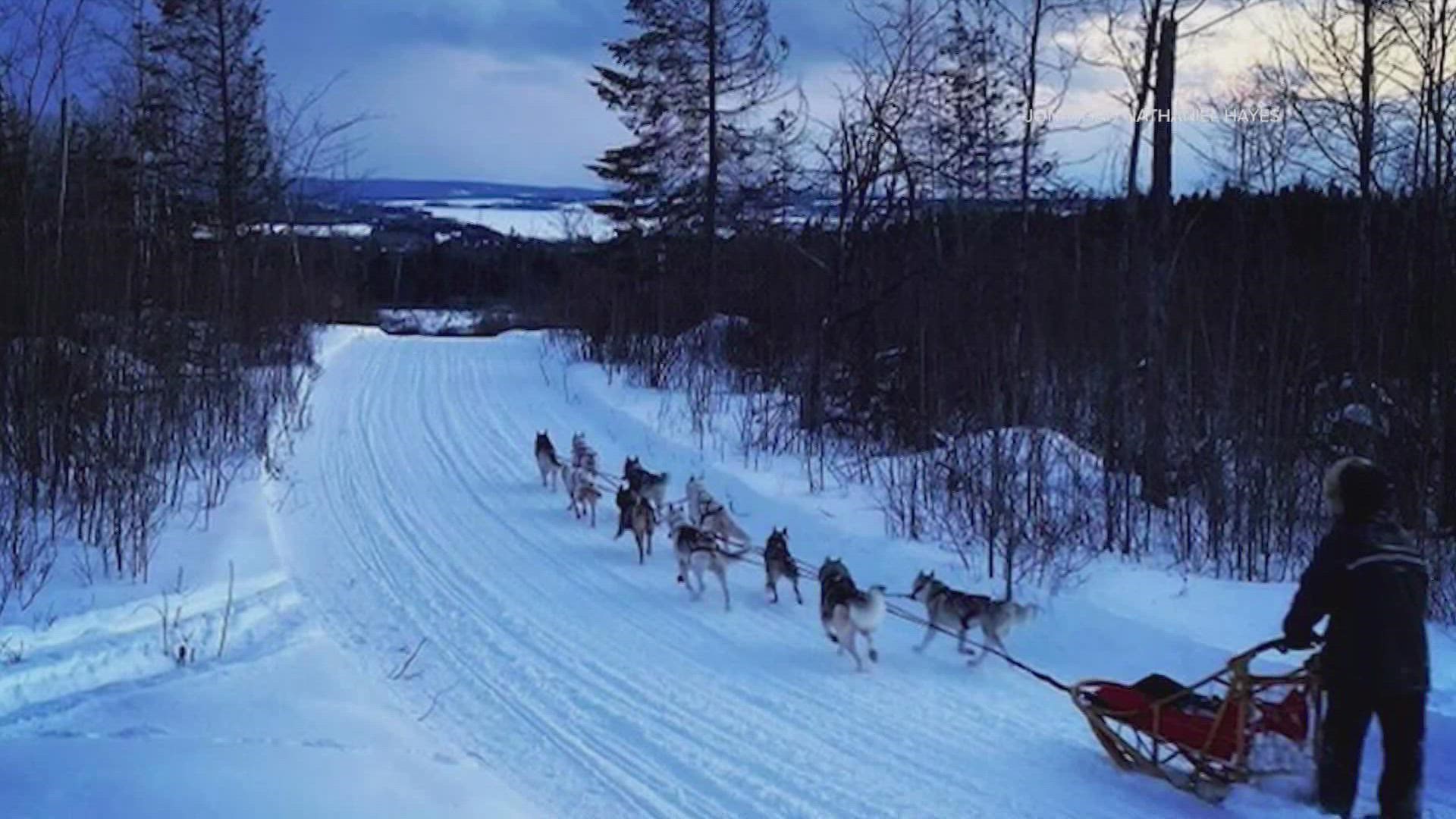MADAWASKA, Maine — It's normal for northern Maine sled dog mushers and their teams to encounter at least some wildlife while training or racing.
"It's usually like a wildlife safari," Jonathan Nathaniel Hayes said.
On Tuesday night, however, that safari took a nasty turn in the Aroostook County village of Saint David.
Hayes and his 17-year-old son, Caleb, returned from a 20-mile training run to find a cow moose stomping and kicking at their kennel of puppies. Hayes was on a snowmobile, and Caleb was on the sled, preparing to compete in this weekend's 100-mile Can-Am Crown International Sled Dog Race in Fort Kent.
When the moose saw them pull up, she directed her attention toward them. Hayes said he pulled the snowmobile in front of Caleb's sled and revved the engine, hoping the machine's lights and sounds would scare off the animal.
"The snowmobile just enraged the moose more, and the moose came over my snowmobile. [...] You don’t realize, really, how big they are," Hayes said. "And I never knew that moose growled until this moment where I’m laying on the ground behind my snowmobile, and she’s standing on the other side of the snowmobile, looking down at me with her ears pinned back with this low growl coming out of her, and I’m like, ‘Ok, this is -- this is pretty scary.”
Hayes said the moose then started to go after Caleb, who had become tangled in the sled's harness system and with the dogs.
"When the team started pulling Caleb toward the moose, the moose turned its attention to the team and charged the team several times, stomping through the team," Hayes explained.
"It probably didn't know the difference between a wolfpack and the sled dog team, because it just charged," Caleb said.
Caleb said the moose retreated every five minutes or so, only to come back with violent attacks at the puppies and the dogs. After about 15 or 20 minutes, Hayes told Caleb to take the snowmobile and try to find a gun from a neighbor while he stayed and held back the dogs.
Caleb went to one neighbor's house, racing through falling snow, but had no luck.
He then went to another neighbor, who was able to give him a muzzleloader, but upon his return to the kennel he found out his dad didn't know how to shoot one.
Third time was the charm, though, as Caleb returned with a Savage 30.06 rifle given to him by a neighbor who he knew.
Caleb handed it to his father, who thought a second before firing.
"I started thinking about him and this experience for him, and I was like, 'How would you like to shoot your first moose?' And he lit up like a Christmas tree and said, 'Yes, sir!' So that's when I handed him the rifle," Jonathan said.
Caleb fired two shots that incapacitated the moose, but the moose did not die. With less chaos, Jonathan called 911, and a Maine Game Warden responded. That warden fired three shots to dispatch the moose.
“It was sad. We saw fury in her eyes, but we also saw fear in her eyes, too, and we talked about that a lot. We could see fear in her eyes as well, and we felt bad for her the entire time. But she had 45 minutes to leave the dog yard and didn’t. We’re believers, so after he gave us the permit we went up there and we prayed and thanked God for her life that way. And we promised her and the Lord that we were going to put the meat to good use and not let it go to waste.”
A Maine Warden Service spokesperson said the Game Warden who responded corroborated the family's story, and issued them a permit to be able to harvest the moose meat.
Warden Service biologist Lee Kantar noted several important themes of moose behavior in an e-mail:
Moose in winter spend majority of their time feeding, ruminating, bedded. As we get into late winter, early spring moose home ranges shrink and moose spend more time ruminating/bedded in softwood cover. When snow is deep and depending on snow conditions (crust, soft, unconsolidated), moose will often use logging roads, snowmobile trails, etc. for accessing areas.
People using the woods in winter need to be respectful and mindful of moose. And that means on the trail or road when encountering moose people need to stop and give the moose time to react and get off the trail and out of the way.
Trying to “get around” a moose while closing the distance or having too get to close to the animal can result in sudden and aggressive behavior. That is the nature of a moose or any animal who has its “bubble” entered. And sometimes that can be unpredictable if one is not familiar with signs of agitation or stress from an animal.
Moose may act nonchalant but can quickly change, this may start with ears on high alert, ears twitching, eye movement/bulging, hackles raised behind head/neck/shoulder and/or movement towards the person. While a moose in the trail or road can be an inconvenience, individuals need to respect wildlife and act accordingly.
NEWS CENTER Maine Anchor and Multiskilled Journalist Chris Costa contributed to this report.

